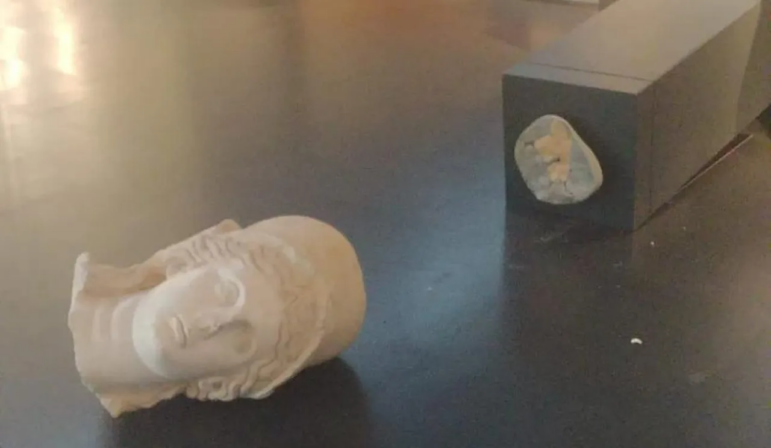Editorial Note: this article is related to events prior to the Israel-Hamas war which began as The Wild Hunt was gathering additional information. We will update this article as needed.
JERUSALEM – An American tourist was arrested in Israel last week for allegedly destroying two Roman statues in the Israel Museum in Jerusalem. The statues were of the Head of Minerva and the Roman goddess, Nemesis. The statues date to the 2nd Century CE and were on permanent exhibition. The vandalism of the two statues occurred on October 5, 2023, prior to the Hamas attack on Israel.
The Israel Museum in Jerusalem is the largest cultural institution in Israel. It is one of the world’s leading art and archaeology museums, housing a vast and diverse collection of artworks and artifacts that represent various cultures and periods from around the world; and of course, cultures of the Levant with significant collections of Judaica ranging from the ancient to the modern era.
The museum’s campus includes the Shrine of the Book, a unique building designed to resemble the lid of the first-century Jewish ritual scroll, where among its most notable collections exhibitions include the Dead Sea Scrolls.
The Museum’s collection of Judaic religious artifacts appears to be part of the motivation for the vandalism.

One of the vandalized sculptures at the Israel Museum. Photo Credit: The Israel Museum
Minerva is the Roman goddess of wisdom, strategic warfare, art, and crafts. She was often associated with the Greek goddess Athena, and the Romans considered Minerva to be the counterpart of Athena in their pantheon. Minerva was revered in Roman society. She was not only seen as the goddess of wisdom but also as the patroness of arts, trade, and strategy. She was often depicted wearing a helmet and carrying a shield, emphasizing her connection to warfare and protection. Additionally, Minerva was considered the inventor of music, medicine, weaving, and other crafts, symbolizing her diverse areas of influence.
Nemesis is depicted as a statue of a griffin seizing the Wheel of Fate. In ancient Roman religion and mythology, Nemesis was the goddess of revenge, retribution, and divine retribution against those who succumb to hubris, arrogance, and excessive pride. She ensured that individuals received what they deserved, whether punishment or reward, based on their actions and behavior. Nemesis was often depicted as a winged goddess holding a measuring rod or a sword and a wheel, symbolizing fate. She was associated with the concept of balance and fairness, making sure that people faced consequences for their deeds.
Nemesis rose in popularity in Roman Judea. The base of the statue bears a Greek inscription that reads, “Year 522. I, Mercurios, son of Alexander, dedicate [this statue] during my priesthood.”

Broken sculpture of Nemesis at the Israel Museum. Photo Credit: The Israel Museum
As per information available on the Israel Museum’s official site, only the head of a once towering 2.5-meter (8 feet) high sculpture of Minerva remains, with traces of paint suggesting it was originally vividly colored. The website notes, “The contrast between the smooth facial features and the textured hair is characteristic of the 2nd century CE style.”
Israeli police say that the man whose name has not been released because of a gag order is a 40-year-old Jewish American tourist who was visiting the museum when he threw the two works of art on the floor.
The man, who was reportedly dressed in religious garb. Authorities said that at the immediate interview upon his arrest, the man said that he believed the statues “to be blasphemous” and “contrary to the Torah.”
“This is a shocking case of the destruction of cultural values,” Director-General Eli Escusido of the Israel Antiquities Authority, said in a statement. “We see with concern the fact that cultural values are being destroyed by religiously motivated extremists.”
The Israel Museum says that the statues have experienced “substantial damage.”
“The Israel Museum considers this incident a troubling and unusual event,” a statement from the museum said. “The museum’s management condemns all forms of violence and hopes such incidents will not recur.”
The statues have been returned to the museum’s conservation department in the hopes of restoration.
The accused man’s attorney, Nick Kaufman, has said that his client’s alleged actions are not a case of religious fanaticism. He argues that this is a case of “Jerusalem Syndrome,” a condition described in an article published in the British Journal of Psychiatry, which claims to have identified and described a specific psychiatric syndrome that emerges in tourists.
The syndrome is triggered by visiting a sacred location and manifests as religiously oriented obsessions and delusions. In one form, the person suffering from the disorder takes on the persona of the character from a sacred text such as the Torah.
The accused man has been ordered to undergo psychiatric evaluation.
Jerusalem Syndrome is not a currently recognized condition in the Diagnostic and Statistical Manual of Mental Disorders (DSM5-TR) or the International Classification of Diseases (ICD-11).
The Wild Hunt is not responsible for links to external content.
To join a conversation on this post:
Visit our The Wild Hunt subreddit! Point your favorite browser to https://www.reddit.com/r/The_Wild_Hunt_News/, then click “JOIN”. Make sure to click the bell, too, to be notified of new articles posted to our subreddit.